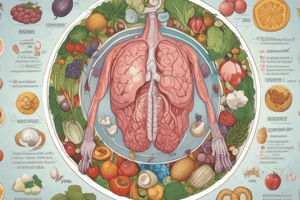Podcast
Questions and Answers
What characterizes saturated fats?
What characterizes saturated fats?
- Contain at least one double bond
- Contain no double bonds (correct)
- Are chemically similar to trans fats
- Lower HDL-C levels
Which type of fat is known to increase LDL-C without affecting HDL-C levels?
Which type of fat is known to increase LDL-C without affecting HDL-C levels?
- Monounsaturated fats
- Polyunsaturated fats
- Saturated fats
- Trans fats (correct)
What is a source of monounsaturated fats (MUFA)?
What is a source of monounsaturated fats (MUFA)?
- Processed meats
- Butter
- Coconut oil
- Fish (correct)
Which type of dietary carbohydrate increases bowel motility?
Which type of dietary carbohydrate increases bowel motility?
What distinguishes positive nitrogen balance?
What distinguishes positive nitrogen balance?
Which monosaccharide is primarily found in fruits and honey?
Which monosaccharide is primarily found in fruits and honey?
Animal proteins are characterized by:
Animal proteins are characterized by:
Which dietary fat classification can potentially reduce both total cholesterol and LDL-C levels?
Which dietary fat classification can potentially reduce both total cholesterol and LDL-C levels?
What does the Tolerable Upper Intake Level (UL) represent?
What does the Tolerable Upper Intake Level (UL) represent?
What is the Estimated Energy Requirement (EER) for a sedentary adult?
What is the Estimated Energy Requirement (EER) for a sedentary adult?
Which macronutrient has the highest energy content per gram?
Which macronutrient has the highest energy content per gram?
What contributes the most to variations in energy requirements?
What contributes the most to variations in energy requirements?
Which process does NOT require energy expenditure from the body?
Which process does NOT require energy expenditure from the body?
What percentage of dietary lipids does Triacylglycerol (TAG) constitute?
What percentage of dietary lipids does Triacylglycerol (TAG) constitute?
What is the thermic effect of food also known as?
What is the thermic effect of food also known as?
Which of the following is NOT a function that requires energy from metabolism?
Which of the following is NOT a function that requires energy from metabolism?
What are the two main categories of nutrients?
What are the two main categories of nutrients?
Which nutrient category includes vitamins and minerals?
Which nutrient category includes vitamins and minerals?
What does the Estimated Average Requirement (EAR) aim to meet?
What does the Estimated Average Requirement (EAR) aim to meet?
When is Adequate Intake (AI) used?
When is Adequate Intake (AI) used?
What percentage of individuals does the RDA estimate to meet their nutrient needs?
What percentage of individuals does the RDA estimate to meet their nutrient needs?
Which micronutrient is NOT included in the list provided?
Which micronutrient is NOT included in the list provided?
The recommended dietary allowance (RDA) is calculated using which formula?
The recommended dietary allowance (RDA) is calculated using which formula?
What are essential nutrients?
What are essential nutrients?
Flashcards are hidden until you start studying
Study Notes
Nutrition Overview
- Nutrients are essential food components needed for normal body functions.
- Two main categories of nutrients:
- Macronutrients: Fats, proteins, carbohydrates
- Micronutrients: Minerals and vitamins
Functions of Nutrients
- Provide energy for bodily functions.
- Supply essential molecules that:
- Cannot be synthesized by the body or
- Are insufficiently synthesized for growth and maintenance.
Essential Nutrients
- Proteins/Amino Acids
- Fatty Acids
- Carbohydrates
- Vitamins: Include both water-soluble and fat-soluble types.
- Minerals: Important minerals include calcium, phosphorus, sodium, potassium, and iron.
Dietary Reference Intakes (DRI)
- DRI serves as guidelines for nutrient intake to prevent deficiencies and ensure optimal health.
- DRI values vary by age and gender.
- Key components of DRI:
- Estimated Average Requirement (EAR)
- Recommended Dietary Allowance (RDA)
- Adequate Intake (AI)
- Tolerable Upper Intake Level (UL)
DRI Definitions
- EAR: Average daily intake level for 50% of healthy individuals within a specific stage and gender.
- RDA: Nutrient amount needed for 97-98% of individuals, calculated using EAR + 2 standard deviations (2SD).
- AI: Used as a guideline when RDA is not available, based on healthy individuals' nutrient intake.
- UL: Maximum daily intake unlikely to cause adverse health effects for most individuals.
Energy Requirements
- Estimated Energy Requirement (EER) is the average intake required for energy balance in healthy adults.
- Recommended energy intake varies by activity level:
- Sedentary adults: 30 kcal/kg/day
- Moderately active adults: 35 kcal/kg/day
- Active adults: 40 kcal/kg/day
Energy Content of Foods
- Energy content measured by calories (kcal), reflecting the total combustion of food.
- Energy values:
- Fats: >2x energy content of proteins or carbohydrates
- Ethanol: Intermediate energy content between fat and carbohydrates.
Energy Use in the Body
- Energy from macronutrients supports three primary processes:
- Basal Metabolic Rate (BMR): Energy for basic functions like respiration and circulation.
- Physical Activity: Varies significantly based on exercise intensity and duration.
- Thermic Effect of Food: Increased energy expenditure (up to 30%) during digestion and absorption.
Dietary Fats
- Triacylglycerols (TAG) make up about 90% of dietary lipids.
- Types of fats:
- Saturated fats: No double bonds; raise LDL cholesterol and heart disease risk (found in meats and dairy).
- Monounsaturated fats (MUFA): One double bond; lower total cholesterol and LDL cholesterol (found in fish and vegetable oils).
- Polyunsaturated fats (PUFA): More than one double bond; effects vary based on fatty acid type (omega-3 and omega-6).
- Trans fats: Behave like saturated fats, increase LDL cholesterol, raise cardiovascular disease risk.
Dietary Carbohydrates
- Types of carbohydrates:
- Monosaccharides: Examples include glucose, fructose, and galactose.
- Disaccharides: Common types include sucrose, lactose, and maltose.
- Polysaccharides: Complex sugars such as starch from plants.
- Dietary fiber: Non-digestible carbohydrates that enhance bowel health and reduce cancer risk.
Dietary Proteins
- Provide essential amino acids necessary for protein synthesis.
- Sources of proteins:
- Animal proteins: Complete amino acid profiles.
- Plant proteins: Generally lower biological value, may lack some essential amino acids.
- Nitrogen Balance: Reflects the balance between nitrogen consumed and excreted.
- Positive nitrogen balance occurs when intake exceeds excretion, often seen in growth phases (children, pregnancy) and during recovery from illness.
Studying That Suits You
Use AI to generate personalized quizzes and flashcards to suit your learning preferences.




